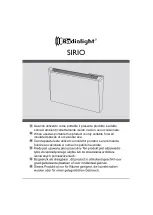
-5-
EFFICIENCY
Efficiencies can be based on either the lower heating value (LHV) or the higher heating value (HHV) of the fuel.
The lower heating value is when water leaves the combustion process as a vapor, in the case of woodstoves the
moisture in the wood being burned leaves the stove as a vapor. The higher heating value is when water leaves
the combustion process completely condensed. In the case of woodstoves this would assume the exhaust gases
are room temperature when leaving the system, and therefore calculations using this heating value consider
the heat going up the chimney as lost energy. Therefore, efficiency calculated using the lower heating value of
wood will be higher than efficiency calculated using the higher heating value. In the United States all woodstove
efficiencies should be calculated using the higher heating value.
As an operator of a wood heater the best way to achieve optimum efficiencies is to learn the burn characteristic
of you appliance and burn well-seasoned wood. A good rule of thumb is that your heater is not producing or
producing very little visible smoke it is burning efficiently. Also remember that higher burn rates are not always
the best heating burn rates; after a good fire is established a lower burn rate may be a better option for efficient
heating. A lower burn rate slows the flow of usable heat out of the home through the chimney, and it also
consumes less wood.
SMOKE AND CO MONITORS
Burning wood naturally produces smoke and carbon monoxide(CO) emissions. CO is a poisonous gas when
exposed to elevated concentrations for extended periods of time. While the modern combustion systems in
heaters drastically reduce the amount of CO emitted out the chimney, exposure to the gases in closed or
confined areas can be dangerous. Also make sure you stove gaskets and chimney joints are in good working
order and sealing properly to ensure unintended exposure. It is recommended that you use both smoke and CO
monitors in areas expected to or having the potential to generate CO.
OPERATIONAL TIPS FOR GOOD, EFFICIENT, AND CLEAN COMBUSTION
Use smaller pieces of wood during start-up and a high burn rate to increase the stove temperature
Be considerate of the environment and only burn dry wood
Burn small, intense fires instead of large, slow burning fires when possible
Learn your appliance's operating characteristics to obtain optimum performance
Burning unseasoned wet wood only hurts your stoves efficiency and leads to accelerated creosote buildup in
your chimney
WOOD SELECTION TIPS
Dead wood lying on the forest floor should be considered wet, and requires full seasoning time. Standing dead
wood can usually be considered to be about 2/3 seasoned. Splitting and stacking wood before it is stored
accelerates drying time. Storing wood on an elevated surface from the ground and under a cover or covered
area from rain or snow also accelerates drying time. A good indicator if wood is ready to burn is to check the
piece ends. If there are cracks radiating in all directions from the center then the wood should be dry enough
to burn. If your wood sizzles in the fire, even though the surface is dry, it may not be fully cured, and should be
seasoned longer.
Summary of Contents for 1269E
Page 22: ...22 NOTES...






































